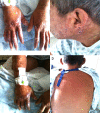Hepatitis C- and HIV-induced porphyria cutanea tarda
- PMID: 24470839
- PMCID: PMC3901625
- DOI: 10.12659/AJCR.889955
Hepatitis C- and HIV-induced porphyria cutanea tarda
Abstract
Patient: Male, 47 FINAL DIAGNOSIS: Porphyria cutanea tarda Symptoms: Chills • cough dry • thumb swelling
Medication: - Clinical Procedure: - Specialty: Metabolic Disorders and Diabetics.
Objective: Challenging differential diagnosis.
Background: Porphyria cutanea tarda (PCT) is the most common type of the porphyria. It occurs due to the deficiency of enzyme uroporphyrinogen decarboxylase (UROD), which is the fifth enzyme in the biosynthesis of heme and catalyzes the conversion of uroporphyrinogen to coproporphyrinogen. The risk factors for PCT include hereditary hemochromatosis, hepatitis C infection, ethanol abuse, estrogen use, HIV, smoking, chlorinated polycyclic aromatic hydrocarbons, and hemodialysis.
Case report: A 47-year-old Hispanic man presented with right thumb swelling, redness, and pain for approximately 1 week. Past medical history included HIV/AIDS, hepatitis C infection, alcohol abuse, heroin abuse, and CMV retinitis. Skin examination revealed blistering and hypo/hyper pigmented lesions over the dorsal aspects of the hands and other sun-exposed areas. Serum porphyrins were discovered to be elevated. The quantitative urine porphyrins revealed elevation of uroporphyrins, heptacarboxyl-porphyrins, hexacarboxy-porphyrins, pentacarboxyl-porphyrins and coproporphyrin. Genetic mutation of UROD was not detected. Due to the classic cutaneous lesions, laboratory findings, and associated risk factors, we were able to confirm our suspicion of the sporadic (type 1) form of PCT.
Conclusions: A strong correlation has been demonstrated between the sporadic (type 1) form of PCT and hepatitis C virus (HCV) infection in multiple studies. The mechanism through which HCV infection may cause or trigger PCT is unknown. PCT has been described for many years, but still eludes the differential diagnosis in a patient with cutaneous findings. The uniqueness of our case is the possibility that combined risk factors have an effect on PCT.
Keywords: Chloroquine; HIV; Hepatitis C – complications; Phlebotomy; Porphyria Cutanea Tarda.
Figures
Similar articles
-
Familial Porphyria Cutanea Tarda.2013 Jun 6 [updated 2022 Jun 9]. In: Adam MP, Feldman J, Mirzaa GM, Pagon RA, Wallace SE, Amemiya A, editors. GeneReviews® [Internet]. Seattle (WA): University of Washington, Seattle; 1993–2025. 2013 Jun 6 [updated 2022 Jun 9]. In: Adam MP, Feldman J, Mirzaa GM, Pagon RA, Wallace SE, Amemiya A, editors. GeneReviews® [Internet]. Seattle (WA): University of Washington, Seattle; 1993–2025. PMID: 23741761 Free Books & Documents. Review.
-
Porphyria cutanea tarda and hepatoerythropoietic porphyria: Identification of 19 novel uroporphyrinogen III decarboxylase mutations.Mol Genet Metab. 2019 Nov;128(3):363-366. doi: 10.1016/j.ymgme.2018.11.013. Epub 2018 Nov 28. Mol Genet Metab. 2019. PMID: 30514647 Free PMC article.
-
Porphyria cutanea tarda: a unique iron-related disorder.Hematology Am Soc Hematol Educ Program. 2024 Dec 6;2024(1):450-456. doi: 10.1182/hematology.2024000664. Hematology Am Soc Hematol Educ Program. 2024. PMID: 39644053 Free PMC article. Review.
-
Porphyria cutanea tarda: Recent update.Mol Genet Metab. 2019 Nov;128(3):271-281. doi: 10.1016/j.ymgme.2019.01.004. Epub 2019 Jan 18. Mol Genet Metab. 2019. PMID: 30683557 Review.
-
Porphyria cutanea tarda--when skin meets liver.Best Pract Res Clin Gastroenterol. 2010 Oct;24(5):735-45. doi: 10.1016/j.bpg.2010.07.002. Best Pract Res Clin Gastroenterol. 2010. PMID: 20955974 Review.
Cited by
-
Human Immunodeficiency Virus Associated Sporadic Nonfamilial Porphyria Cutanea Tarda.Indian J Dermatol. 2016 May-Jun;61(3):318-20. doi: 10.4103/0019-5154.182424. Indian J Dermatol. 2016. PMID: 27293254 Free PMC article.
-
Drug-associated porphyria: a pharmacovigilance study.Orphanet J Rare Dis. 2024 Aug 1;19(1):286. doi: 10.1186/s13023-024-03294-8. Orphanet J Rare Dis. 2024. PMID: 39090656 Free PMC article.
-
Porphyria Cutanea Tarda Associated With Acute Hemorrhagic Pancreatitis.J Investig Med High Impact Case Rep. 2019 Jan-Dec;7:2324709619852769. doi: 10.1177/2324709619852769. J Investig Med High Impact Case Rep. 2019. PMID: 31155958 Free PMC article.
-
Understanding Hepatic Porphyrias: Symptoms, Treatments, and Unmet Needs.Semin Liver Dis. 2024 May;44(2):209-225. doi: 10.1055/s-0044-1787076. Epub 2024 May 17. Semin Liver Dis. 2024. PMID: 38772406 Free PMC article. Review.
-
Erythropoietic Protoporphyria-related Hepatopathy Successfully Treated with Phlebotomy.Intern Med. 2018;57(17):2505-2509. doi: 10.2169/internalmedicine.0673-17. Epub 2018 Sep 1. Intern Med. 2018. PMID: 30175727 Free PMC article.
References
-
- Gisbert JP, Garcia-Buey L, Pajares JM, Moreno-Otero R. Prevalence of Hepatitis C virus infection in porphyria cutanea tarda. systematic review and a meta-analysis. J Hepatol. 2003;39(4):620–27. - PubMed
-
- Egger NG, Goeger DE, Payne DA, et al. Porphyria cutanea tarda multiplicity of risk factor including HFE mutations, hepatitis C and inherited uroprophyrinogen decarboxylase deficiency. Dig Dis Sci. 2002;47(2):419–26. - PubMed
-
- Tarwater K, Misra S, Misra M. Type I (sporadic) porphyria cutanea tarda in a hemodialysis patient: A case report. Hemodial Int. 2008;12(2):S38–42. - PubMed
-
- Fargion S, Fracanzani AL. Prevalence of Hepatitis C virus infection in porphyria cutanea tarda. J Hepatol. 2003;399(4):635–38. - PubMed
LinkOut - more resources
Full Text Sources
Other Literature Sources
Miscellaneous

